
|   |

|   |
 e-mail: ukb7@rediffmail.com Collage of cadences February 25, 2018 Traditional Odissi In an unbroken tradition of scholarly tomes on Indian performing arts that began from before the Christian millennium and continued till Sarangadeva's Sangeet Ratnakara in the 13th century, marked a water-shed treatise from which point, many experts believe, the Hindustani and Carnatic music went their own way. Meanwhile, new texts and manuals started appearing that covered the regional forms of the performative arts. For instance, in Kerala, Ramayana Sankshepam came out as an Attaprakaram (acting manual) for depicting the story of Ramayana as used in Kutiyattam dance theatre around the 9th century. The acting manual - written to depict the mudras for narrating the epic story - had the minimum of words arranged along with the mudras in the same sequence. The text comprised three segments: Ashcharya Choodamani (by Shaktibhadra, a contemporary of saint Shankaracharya), Pratima and Abhishekham (both presumably by Bhasa). In northeast India - the other end of the subcontinent - Srihasta Muktavali by Shubhankara was used as an acting manual for Sattriya dance - practised in Assam's Sattras - that was codified sometime after saint Sankaradeva's time in the 16-17th century. In the Odisha coast, there appeared a very definitive text, Abhinaya Chandrika, laying down foot position, hand gestures, facial expressions, glances, chest movements, et al. Written by Maheshvar Mohapatra around the middle of the 18th century, the manual seemed to be produced during the reign of Anangabhima of the Ganga dynasty, who built the towering shrines around the 12th century Jagannath temple. Its contents covered the minutiae of the Odra dance in three parts: Nritya, Nritta and Chhanda. Nritya gave instructions on lasya expressions, hasta, pada, tandava, tala, chari, costume and jewellery, besides bhava and rasa, whereas Nritta delineated movements of face, chest, neck, etc. Chhanda depicted the seven swaras and associated srutis, besides pallavis. Taranga Festival presented by Saveri Odissi Dance School on February 13 at the ICCR, showcased traditional Odissi dance, based squarely on the text of Abhinaya Chandrika, inspired obviously by the billowy waves of the Bay of Bengal washing Odisha's shores. Just as waves lap up the land's coastline following each other, the festival seemed to be an attempt to preserve Odisha's legacy among the present new wave of dancers. Two features stood out in the programme. One, all the choreographies harked back to Guru Kelucharan Mohapatra, barring two by his equally eminent disciple Sanjukta Panigrahi. Two, all the accompanying compositions - as recorded music - were by Odisha's icons Pt. Bhubaneswar Misra and Raghunath Panigrahi. 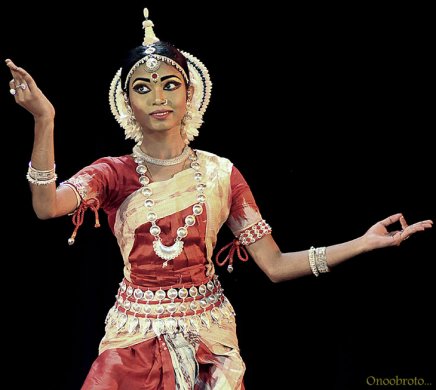 Moumita Dutta 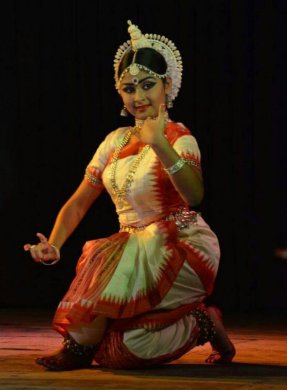 Asmita Kar 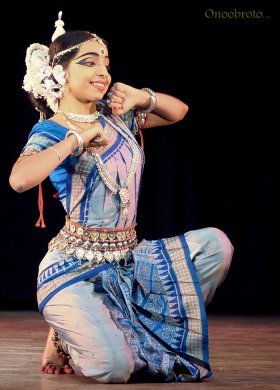 Shinjinee Bhattacharya 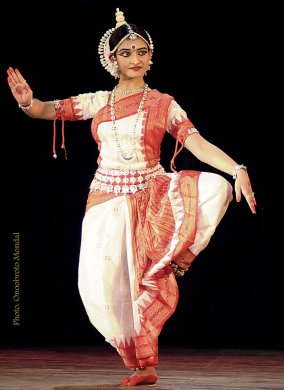 Moumita Pal The youthful dancers - with an average of 10 to 15 years of grooming and almost all of them scholarship holders -- were uniformly a delight to watch. Moumita Dutta began with a Mangalaacharan with a Shiva Panchakshara Stotram, beginning picturesquely with a syllable from the words Namah Shivaya. A 13-year-old Asmita Kar followed with a Saveri Pallavi, with a slow rhythm and progressed, with rising momentum, towards a thunderous crescendo. Shinjinee Bhattacharya came next in an abhinaya, To lagi gopa danda mono re Kalia suna..., narrating how Radha and other milkmaids are unable to reach the Yamuna bank due to Krishna's endless pranks. Moumita's Durga Stuti Jatajuta samayuta... described graphically the mother goddess's many attributes and the ten weapons she wields to kill the evil demon Mahisasura. Moumita Dutta re-appeared with a beautiful Kirwani Pallavi. Asmita Kar was also back with an ashtapadi Lalita lavanga lata parisheelana... with Radha's companion announcing the advent of spring with the soft cinnamon plants rendering the breeze mellow and gentle. Moumita Pal appeared with a Behag Pallavi, distinguished by graceful, flowing movements inspired by Nature. Shinjinee Bhattacharya came again, with a young maiden mesmerized by monsoon's torrential downpour, the lightning to enliven the dark clouds and the roaring winds giving a wild cry. 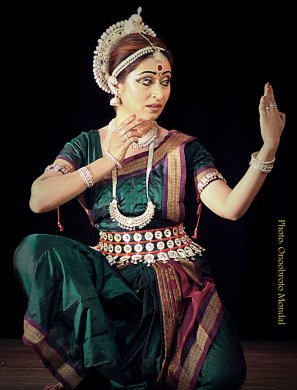
Nandini Ghoshal
Guru Nandini Ghoshal, a veteran of both stage and the celluloid, offered her Behag Pallavi in a Yugma Dwanda (mutual duel) mode, with music and dance working out an intricate encounter between the music's rhythmic pattern and the racy movements of the dancer's tempo. The finale was the famous ashtapadi on the khandita nayika from Gita Govinda, Yahi Madhava, yahi Keshava... that suited Nandini's acting prowess to the hilt. Now she was the expectant sweetheart, now the upstaged heroine, now the wrathful maiden and now the hell's fury let loose as the woman scorned... Jugalbandi Our classical dances, having evolved over the last seven decades since Independence, have now lived cheek by jowl with each other among their ardent practitioners. It is perhaps as good a time as any other to look at some of their proximate issues and examine prospects and possibilities. One may begin, for instance, from their Margams and examine how their basic exercises, abhinaya and nritta - to take only three aspects - would feature at a confluence of two nearby styles. A second angle may be the rhythms of two nearby styles' percussion support and allow for a scrutiny as to how their sound would resonate and reverberate. Yet a third point of view may be to inject a dose of theatricality and contemporaneity, and try then to see how the classical forms innovate. In fact, such ideas can be galore, but one has to start somewhere! Jugalbandi presented by half a dozen established classical dance groups from Kolkata and Michigan, USA on February 15, 2018 at ICCR, did just the above kind of experimentation and invited many curious glances. Basically, it was the conclave of a few thoughtful artistes, who looked intent to expand their creative horizons with new choreographies and attempt collaborations across artistic genres. At the outset, this critic would wholeheartedly welcome any such innovative venture.
Ekayan, the first segment, was an encounter between Mohiniattam and Bharatanatyam -- from the peninsular India with sufficiently close idioms - led by Priyadarshini Ghosh and Mohana Iyer with Natyanova in Mohiniattam and Sujatha Ramalingam with Kalasrishti in Bharatanatyam. Their groups established the two forms, juxtaposing the invocatory item of each style. The performance commenced in Bharatanatyam with a prayer to Ganesha in raga Hamsadhwani and adi tala, followed by Bhramari Allarippu in tisra ekam, and Chollkettu in Mohiniattam in Ragamalika and chempada tala. The second piece was a composition penned by Maharaja Swati Tirunal in Ragamalika and rupaka tala. This was an abhinaya item depicting the eternal virahotkanthita nayika pining for union with Padmanabha. Integrating both the styles with the main abhinaya portions, it was performed by the three main artists: Priyadarshini, Mohana and Sujatha. Their finale was a Tillana, celebrating pure dance in a jugalbandi of the two styles by the combined artists of Kalasrishti and Natyanova, in raga Chenchurutti and rupaka tala. In the second segment, Nada Brahma (the sound of God), the cosmos was sought to be perceived. Nada Swarupam explored the concept of a beginning with sound symbolising creation, followed by rhythm and pure dance that emanated from sound, and explored preservation of the universe by Vishnu, and destruction and purification by Shiva. At the end, through Nada, the artiste becomes one with the universe. The production used the versatility of the two eastern classical styles of Manipuri and Odissi and included the Pung (percussion) and Manjira (cymbals) played on stage by the dancers. The admirable concept, direction and choreography were by Poushali Chatterjee for Manipuri and Arpita Venkatesh for Odissi, along with artistes of Nandanik and Malashree respectively.
Duhshamay, a profound poem by Tagore, constituted the final segment, using the dance vocabularies of Odissi and Kathak, along with physical theatre and contemporary dance to interpret the layers of meaning, depths of philosophy and mysticism inherent in them. Returning repeatedly to Tagore's visual imagery of a blind bird that struggles to spread its broken wings and still let its spirits soar, this highly imaginative work traced a metaphorical journey, with no beginning and no end. Time and space were mere illusions on this journey -- as transitory as both fear and hope, as well as all the human bonds -- with the eternal spirit seeking to transcend it all. The choreography by Shreyashi Dey in Odissi and Anurekha Ghosh in Kathak, both exposed considerably to the contemporary idiom in the West, blended liberally tradition with modernity. Dheeman Bhattacharyya's was the anguished cry of the poet with his physical acting, while Aakash Kirtaniya - sliding down his illusory rope -- remained the elusive spirit of time, supremely unconcerned to the worldly ways of the others.  Dr. Utpal K Banerjee is a scholar-commentator on performing arts over last four decades. He has authored 23 books on Indian art and culture, and 10 on Tagore studies. He served IGNCA as National Project Director, was a Tagore Research Scholar and is recipient of Padma Shri. Post your comments Please provide your name and email id when you use the Anonymous profile in the blog to post a comment. All appropriate comments posted with name & email id in the blog will also be featured in the site. |